Influence of Thermal Retrofitting on Annual Energy Demand for Heating in Multi-Family Buildings
Abstract
1. Introduction
2. Materials and Methods
2.1. Method of Determining the Energy Coefficients
- (1)
- Acquisition of data from legalized heat meters operating under actual conditions, collected for each building over the period of several years, i.e., measurement of heat consumption for heating in main pipes, before dividers (Qp, GJ/year).
- (2)
- Collection of the data from heating suppliers, pertaining to the length of the heating period and mean monthly outdoor air temperatures in a given location.
- (3)
- Calculation of the number of degree-days for each analyzed year, according to the following dependency:where:
- Sd is the number of degree-days calculated for a particular year, day·K/year;
- θe,m is the mean monthly outdoor air temperature in a given year, °C;
- θint,,H is theindoor air temperature in the heated zone, assumed at 20 °C;
- Ldm is thenumber of heating days in a given month of a given year, day.
- (4)
- Calculation of a correction coefficient resulting from the variability of the number of degree days according to the following dependency:where:
- φ is the correction coefficient;
- Sd0 is the number of degree-days in the standard year, calculated on the basis of mean monthly outdoor air temperatures obtained from multiannual measurements and theoretical length of the heating season (222 days), which, in the case of the location of the analyzed buildings amounts to 3825.2 (day·K)/year.Table 2 contains the values of correction coefficient in a given group and a given year, as well as the years for which the heat consumption measurements were conducted.
- (5)
- Correction of the measured consumed heat values to the standard year conditions performed in line with the following dependency:where:
- Q0 is the adjusted annual heat consumption, i.e., adjustment to standard conditions, GJ/year;
- Qp is the measured annual heat consumption, GJ/year.
- (6)
- Collection of the data from energy audits conducted for the analyzed buildings, pertaining to the predicted level of energy savings obtained through thermal retrofitting.
- (7)
- Determining the final energy savings in accordance with the following dependencies:where:ΔQ% = (Q01,avg − Q02,avg)/Q01,avg ·100
- , ΔQ%,min, and ΔQ%,max are the mean, minimal, and maximal (respectively) obtained reduction in final energy consumption following thermal retrofitting related to the value of mean annual final energy consumption prior to thermal retrofitting of the building, %;
- Q01,avg is the mean annual final energy consumption before thermal retrofitting under standard conditions, GJ/year;
- Q02,avg is the mean annual final energy consumption after thermal retrofitting under standard conditions, GJ/year.
- (8)
- Comparison of the energy savings level obtained under the operational conditions with the level predicted in energy audits.
- (9)
- Calculation of the annual final energy factor for heating after thermal retrofitting under operational conditions, according to the following dependencies:where:
- FEFH is the annual final energy factor for heating, kWh/(m2·year);
- Af is the heated usable surface area of the building, m2;
- 106 is the unit converter, kJ/GJ;
- 3600 is the unit converter, s/h.
- (10)
- Determination of the annual non-renewable primary energy factor for heating after thermal retrofitting under operational conditions, in line with the following dependence:PEFH = wH ·FEFH
- (11)
- Calculation of the boundary value of the factor of annual non-renewable primary energy demand for heating as a function of building shape coefficient, according to the national regulations for new and modernized buildings, at a time of thermal retrofitting, in line with the following dependence:new buildings PEFH,0 = 55 + 90 · (A/V)where:modernized buildings PEFH,0 = 1.15 · [55 + 90 · (A/V)]
- PEFH,0 is the maximum value of annual non-renewable primary energy factor for heating, kWh/(m2·year)
- (12)
- Comparison of the factor of the annual non-renewable primary energy factor for heating after thermal retrofitting under operational conditions with the limit values established in Polish regulations [34] at the time of investment.
2.2. Description of the Data Analysis Methods
3. Results
4. Discussion
5. Conclusions
- The thermal retrofitting conducted in multi-family residential buildings result in reduced heat consumption for heating ranging from 14 to 43%. The level of achieved final energy savings depends on the improvement degree of the technical parameters of wall barriers and efficiency of the heating system in a building. The more comprehensive the thermal retrofitting is and the greater the improvement of these parameters, the higher the reduction in heat consumption.
- The analysis indicates that the predicted savings determined on the basis of the calculations performed in accordance to the applicable algorithms found in respective standards and national legal acts are usually higher than the actual values. On the basis of the conducted studies, the mean obtained from an audit amounts to 38.4%, whereas from measurements, the mean obtained amounts to 30.2%. It should be noted that the predicted effects can be achieved under the operational conditions, which happened most often in group G2. Varying energy effects are obtained in different years, even within the same building. It is likely that this is connected with the method of energy supply and usage in particular rooms of a building.
- Despite similar parameters of wall barriers, the building shape coefficient (A/V = 0.31 to 0.5), and total efficiency of heating installations in the final state, some buildings were characterized with much higher values of the FEFH factor. These were mainly the objects belonging to group G4. This means that these buildings varied in terms of use, operation, and energy management. It should also be assumed that the method of energy management in a building largely affects its energy quality under the operational conditions. Therefore, thermal retrofitting of a building can be conducted to the same extent, yielding different energy effects under the actual conditions. This is indicated by diversified FEFH values both within a single group and between them.
- The buildings from groups G1 and G2 with input coefficient wH = 0.8 met the requirements for the annual primary energy factor, with mean values equal 104.9 and 101.5 kWh/(m2·year), respectively, with the measured average value of this factor equal to 57 kWh/(m2·year). On the other hand, the objects from groups G3 and G4 (with wH = 1.3) did not meet those requirements, reaching greater PEFH values compared to the boundary PEFH,0 values (110 and 104.8 kWh/(m2·year), respectively).
- All buildings supplied from a district heating system with a co-generational heat source met the requirements of modernized buildings found in technical guidelines. However, not every building supplied from a district heating system equipped with coal heat plant met the requirements related to the PEFH,0 factor value, despite a FEFH factor that was comparable to other buildings. This is indicated through the comparison of the FEFH and PEFH factors in groups G1 and G2 to the values of these factors in G3.
- The current requirements give a boundary value for the primary energy factor (PEFH+W, 0) for heating combined with hot water production, so it is not possible to say what the limit value for heating is. However, in the period in which the heat consumption of the modernized facilities was analyzed, it was possible to compare the consumption for heating purposes of the PEFH,0 limit value, but only for heating purposes.
Author Contributions
Funding
Conflicts of Interest
References
- European Commission. Second Report on the State of the Energy Union; European Commission: Brussels, Belgium, 2017; Available online: https://ec.europa.eu/commission/sites/beta-political/files/2nd-report-state-energy-union_en.pdf (accessed on 2 September 2020).
- European Commission. Climate Action Paris Agreement. Available online: https://ec.europa.eu/clima/policies/international/negotiations/paris_en (accessed on 2 September 2020).
- Wang, B.; Xia, X.; Zhang, J. A multi-objective optimization model for the life-cycle cost analysis and retrofitting planning of buildings. Energ. Build. 2014, 77, 227–235. [Google Scholar] [CrossRef]
- Fan, Y.; Xia, X. A multi-objective optimization model for energy-efficiency building envelope retrofitting plan with rooftop PV system installation and maintenance. Appl. Energ. 2017, 189, 327–335. [Google Scholar] [CrossRef]
- Act of Polish Government of 18 December 1998 on Supporting Thermomodernization Projects; Warsaw, Poland, 1998. Available online: http://isap.sejm.gov.pl/isap.nsf/DocDetails.xsp?id=WDU19981621121 (accessed on 2 September 2020).
- Regulation of The Polish Minister of Interior and Administration of 30 April 1999 Concerning Scope and form of the Energy Audit as well as Algorithms for Assessing the Profitability of Thermo-Modernization Project and the Patterns of the Energy Audit Cards. Available online: http://prawo.sejm.gov.pl/isap.nsf/DocDetails.xsp?id=WDU19990460459 (accessed on 2 September 2020).
- Directive 2002/91/EC of the European Parliament and of the Council of 16 December 2002 on the Energy Performance of Buildings. Available online: https://eur-lex.europa.eu/legal-content/EN/TXT/?uri=CELEX%3A32002L0091 (accessed on 2 September 2020).
- Życzyńska, A.; Suchorab, Z.; Kočí, J.; Černý, R. Energy effects of retrofitting the educational facilities located in south-eastern poland. Energies 2020, 13, 2449. [Google Scholar] [CrossRef]
- Życzyńska, A. The influence of heating and hot water system on the energy performance of a building. Rynek Energii 2009, 6, 46–54. [Google Scholar]
- Regulation of the Minister of Infrastructure of 14 November 2017 amending the Regulation on the Technical Conditions to be Met by Buildings and Their Location. Available online: http://isap.sejm.gov.pl/isap.nsf/DocDetails.xsp?id=WDU20170002285 (accessed on 2 September 2020).
- Mejjaouli, S.; Alzahrani, M. Decision-making model for optimum energy retrofitting strategies in residential buildings. Sustain. Prod. Consump. 2020, 24, 211–218. [Google Scholar] [CrossRef]
- Piccardo, C.; Dodoo, A.; Gustavsson, L.; Tettey, U. Retrofitting with different building materials: Life-cycle primary energy implications. Energy 2020, 192, 116648. [Google Scholar] [CrossRef]
- Brzyski, P.; Barnat-Hunek, D.; Suchorab, Z.; Łagód, G. Composite materials based on hemp and flax for low-energy buildings. Materials 2017, 10, 510. [Google Scholar] [CrossRef]
- Barnat-Hunek, D.; Siddique, R.; Łagód, G. Properties of hydrophobised lightweight mortars with expanded cork. Constr. Build. Mater. 2017, 155, 15–25. [Google Scholar] [CrossRef]
- Barnat-Hunek, D.; Widomski, M.; Szafraniec, M.; Łagód, G. Impact of different binders on the roughness, adhesion strength, and other properties of mortars with expanded cork. Materials 2018, 11, 364. [Google Scholar] [CrossRef]
- Nemry, F.; Uihlein, A.; Colodel, C.M.; Wetzel, C.; Braune, A.; Wittstock, B.; Hasan, I.; Kreißig, J.; Gallon, N.; Niemeier, S.; et al. Options to reduce the environmental impacts of residential buildings in the European Union—Potential and costs. Energ. Build. 2010, 42, 976–984. [Google Scholar] [CrossRef]
- Dodoo, A.; Gustavsson, L.; Sathre, R. Life cycle primary energy implication of retrofitting a wood-framed apartment building to passive house standard. Resour. Conserv. Recy. 2010, 54, 1152–1160. [Google Scholar] [CrossRef]
- Pombo, O.; Allacker, K.; Rivela, B.; Neila, J. Sustainability assessment of energy saving measures: A multi-criteria approach for residential buildings retrofitting—A case study of the Spanish housing stock. Energ. Build. 2016, 116, 384–394. [Google Scholar] [CrossRef]
- Ramírez-Villegas, R.; Eriksson, O.; Olofsson, T. Life cycle assessment of building renovation measures–trade-off between building materials and energy. Energies 2019, 12, 344. [Google Scholar] [CrossRef]
- Wang, Q.; Holmberg, S. Combined retrofitting with low temperature heating and ventilation energy savings. Energy Procedia 2015, 78, 1081–1086. [Google Scholar] [CrossRef][Green Version]
- Song, X.; Ye, C.; Li, H.; Wang, X.; Ma, W. Field study on energy economic assessment of office buildings envelope retrofitting in southern China. Susain. Cities Soc. 2017, 28, 154–161. [Google Scholar] [CrossRef]
- Mehlika, N.; Inanici, F.N.D. Thermal performance optimization of building aspect ratio and south window size in five cities having different climatic characteristics of Turkey. Build. Environ. 2000, 35, 41–52. [Google Scholar]
- El-Darwish, I.; Gomaa, M. Retrofitting strategy for building envelopes to achieve energy efficiency. Alex. Eng. J. 2017, 56, 579–589. [Google Scholar] [CrossRef]
- De Rosa, M.; Bianco, V.; Scarpa, F.; Tagliafico, L.A. Heating and cooling building energy demand evaluation; a simplified model and a modified degree days approach. Appl. Energ. 2014, 128, 217–229. [Google Scholar] [CrossRef]
- Mazzola, E.; Dalla Mora, T.; Peron, F.; Romagnoni, P. An integrated energy and environmental audit process for historic buildings. Energies 2019, 12, 3940. [Google Scholar] [CrossRef]
- Regulation of the Polish Minister of Infrastructure of 17 March 2009 Concerning Scope and form of the Energy Audit and the Repair Audit, Design Audits Cards, as well as Algorithms for Assessing the Profitability of Thermo-Modernization Project. Available online: http://isap.sejm.gov.pl/DetailsServlet?id=WDU20090430347 (accessed on 2 September 2020).
- Marrone, P.; Gori, P.; Asdrubali, F.; Evangelisti, L.; Calcagnini, L.; Grazieschi, G. Energy benchmarking in educational buildings through cluster analysis of energy retrofitting. Energies 2018, 11, 649. [Google Scholar] [CrossRef]
- Biserni, C.; Valdiserri, P.; D’Orazio, D.; Garai, M. Energy retrofitting strategies and economic assessments: The case study of a residential complex using utility bills. Energies 2018, 11, 2055. [Google Scholar] [CrossRef]
- Mancini, F.; Nastasi, B. Energy retrofitting effects on the energy flexibility of dwellings. Energies 2019, 12, 2788. [Google Scholar] [CrossRef]
- Cholewa, T.; Balaras, C.A.; Nižetić, S.; Siuta-Olcha, A. On calculated and actual energy savings from thermal building renovations: Long term field evaluation of multifamily buildings. Energ. Buildings 2020, 223, 110145. [Google Scholar] [CrossRef]
- Woroniak, G.; Piotrowska-Woroniak, J. Effects of pollution reduction and energy consumption reduction in small churches in Drohiczyn community. Energ. Build. 2014, 72, 51–61. [Google Scholar] [CrossRef]
- Życzyńska, A. The heat consumption and heating costs after the insulation of building partitions of building complex supplied by the local oil boiler room. Eksploat. Niezawodn. 2014, 16, 313–318. [Google Scholar]
- Regulation of the Polish Minister of Infrastructure of 27 February 2015 Concerning the Methodology for Calculating the Energy Performance of the Building or Part of a Building and the Preparation of Certificates of Energy Performance. Available online: http://prawo.sejm.gov.pl/isap.nsf/DocDetails.xsp?id=WDU20150000376 (accessed on 2 September 2020).
- Regulation of the Polish Minister of Infrastructure of 6 November 2008 Concerning the Methodology for Calculating the Energy Performance of the Building and a Residential Unit or Part of a Building which is the whole Technical-Independent Utility and the Preparation and Presentation of Certificates of Energy Performance. Available online: http://isap.sejm.gov.pl/DetailsServlet?id=WDU20082011240 (accessed on 2 September 2020).
- Fay, M.P.; Proschan, M.A. Wilcoxon-Mann-Whitney or t-test? On assumptions for hypothesis tests and multiple interpretations of decision rules. Statist. Surv. 2010, 4, 1–39. [Google Scholar] [CrossRef]
- Kim, T.K.; Park, J.H. More about the basic assumptions of t-test: Normality and sample size. Korean J. Anesthesiol. 2019, 72, 331–335. [Google Scholar] [CrossRef]
- Shapiro, S.S.; Wilk, M.B. An analysis of variance test for normality (complete samples). Biometrika 1965, 52, 591–611. [Google Scholar] [CrossRef]
- Bowerman, B.L.; Mason, R.L.; Gunst, R.F.; Hess, J.L. Statistical design and analysis of experiments with applications to engineering and science. Technometrics 1991, 33, 106. [Google Scholar] [CrossRef]
- Vargha, A.; Delaney, H.D. A Critique and improvement of the “CL” common language effect size statistics of mcgraw and wong. J. Educ. Behav. Stat. 2000, 25, 101–132. [Google Scholar]
- Corder, G.W.; Foreman, D.I. Nonparametric Statistics for Non-Statisticians: A Step-by-Step Approach; John Wiley & Sons, Inc.: Hoboken, NJ, USA, 2009; ISBN 978-1-118-16588-1. [Google Scholar]
- Albers, C.; Lakens, D. When power analyses based on pilot data are biased: Inaccurate effect size estimators and follow-up bias. J. Exp. Soc. Psychol. 2018, 74, 187–195. [Google Scholar] [CrossRef]
- Marcus, R.; Eric, P.; Gabriel, K.R. On closed testing procedures with special reference to ordered analysis of variance. Biometrika 1976, 63, 655–660. [Google Scholar] [CrossRef]
- R Core Team. R: A Language and Environment for Statistical Computing. 2020. Available online: https://www.r-project.org/ (accessed on 2 September 2020).
- Kassambara, A. Ggpubr: “Ggplot2” Based Publication Ready Plots. Available online: https://cran.r-project.org/web/packages/ggpubr/index.html (accessed on 2 September 2020).
- Kassambara, A. Rstatix: Pipe-Friendly Framework for Basic Statistical Tests. Available online: https://cran.r-project.org/web/packages/rstatix/index.html (accessed on 2 September 2020).
- Indrajeet, P.; Powell, C.; Beasley, W.; Heck, D.; Hvitfeldt, E.; Baniecki, H. Maintenance release and adjusting for pairwise Comparisons changes. Zenodo 2020. Available online: https://zenodo.org/record/2074621 (accessed on 2 September 2020).
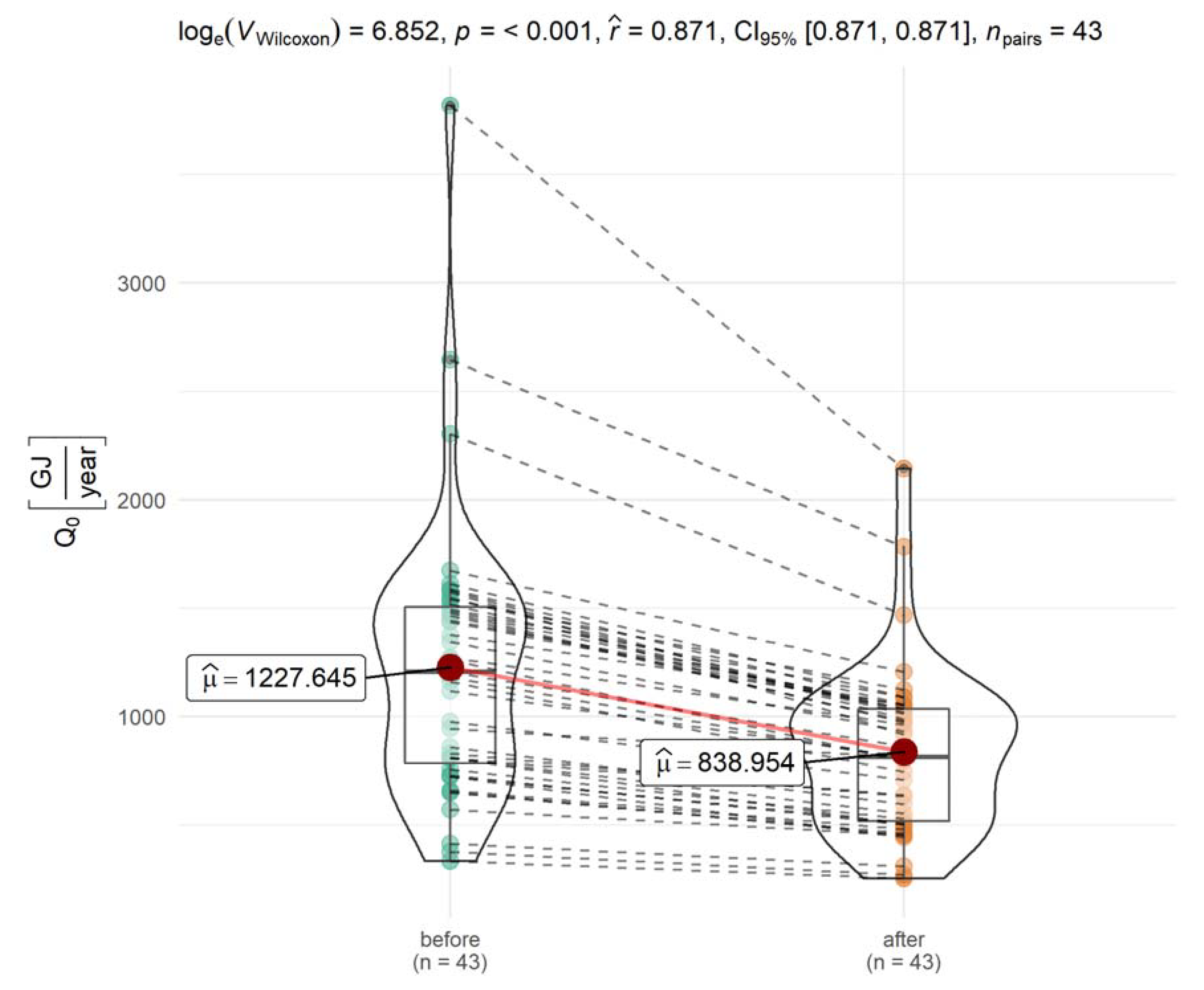
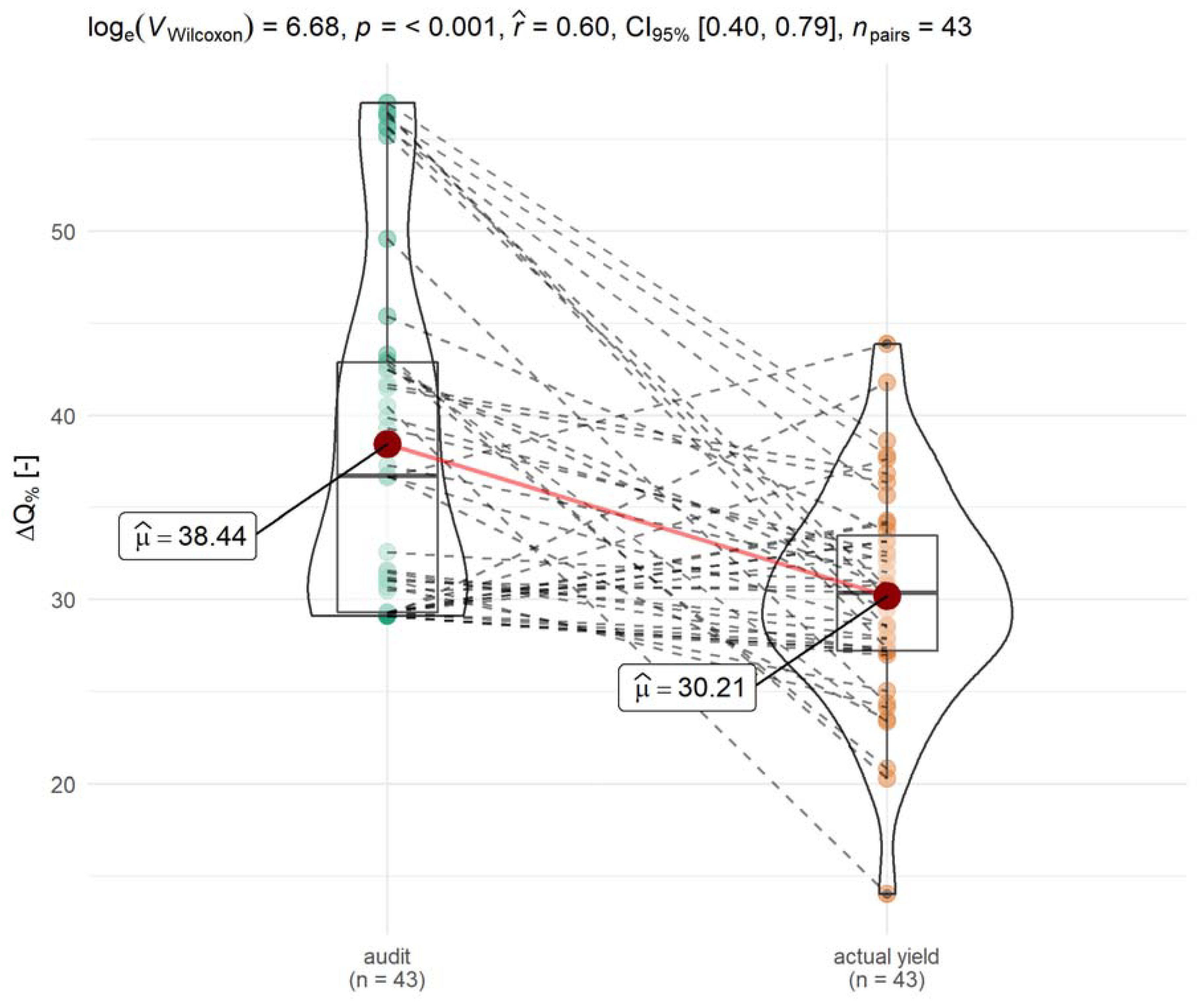
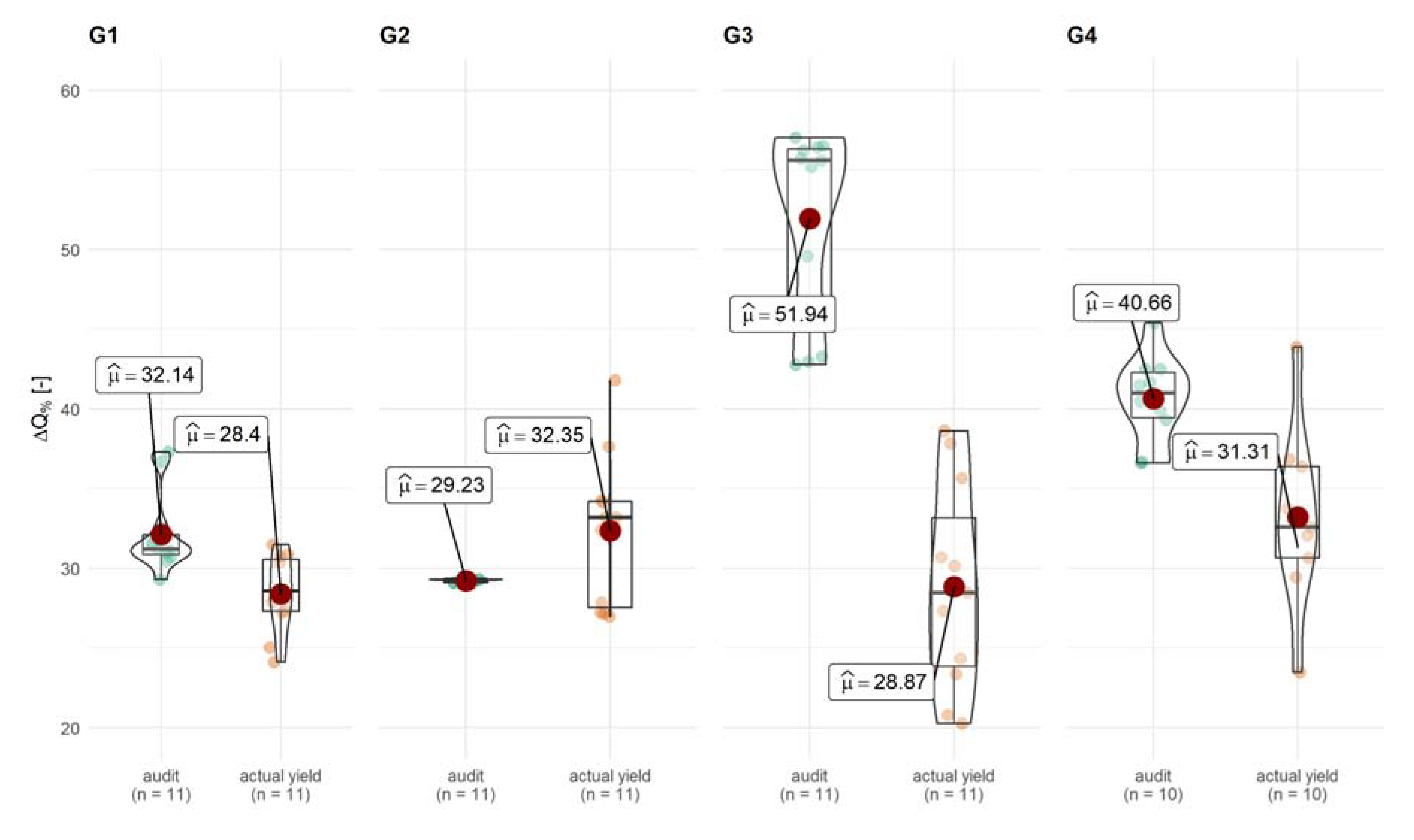
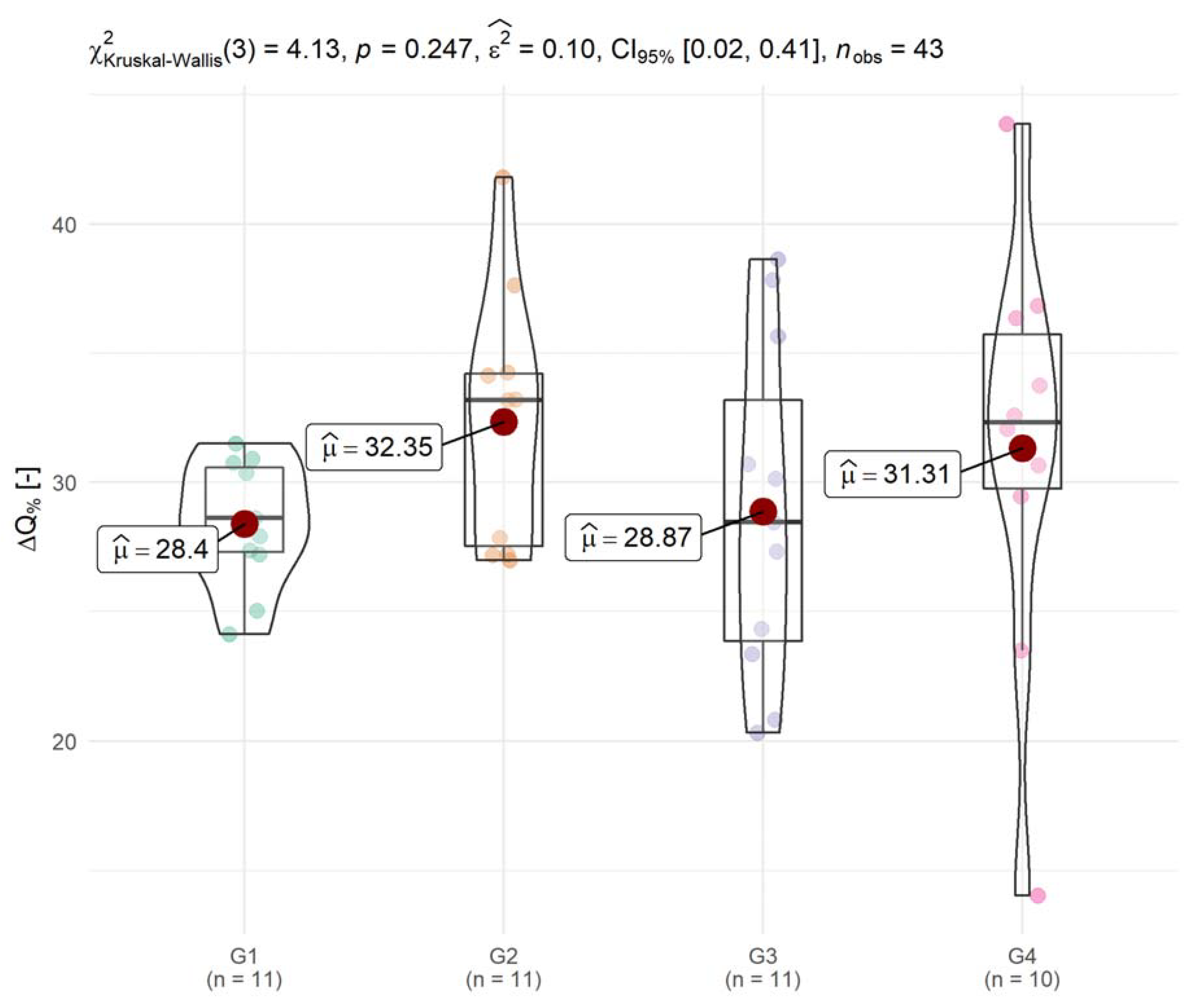
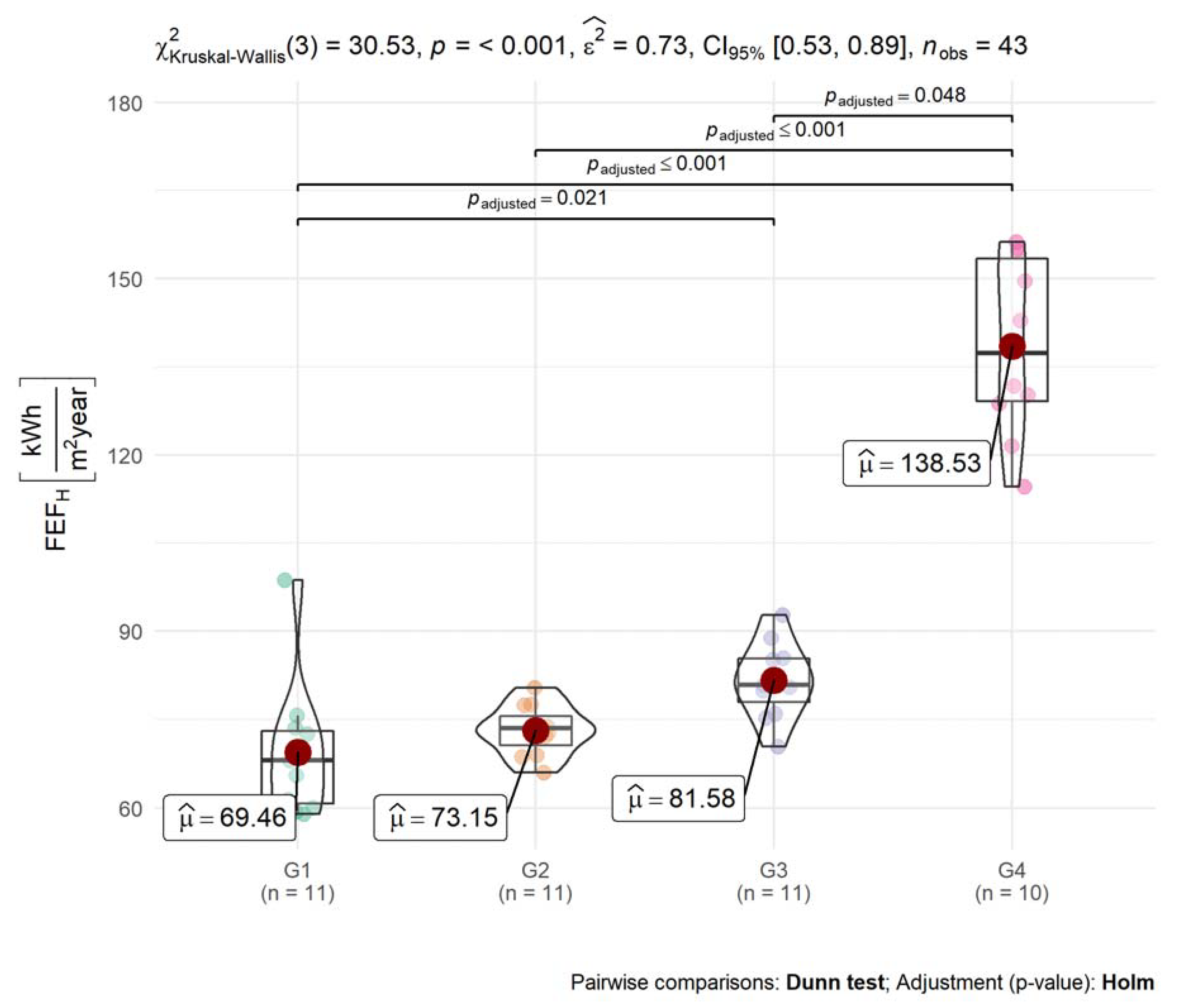
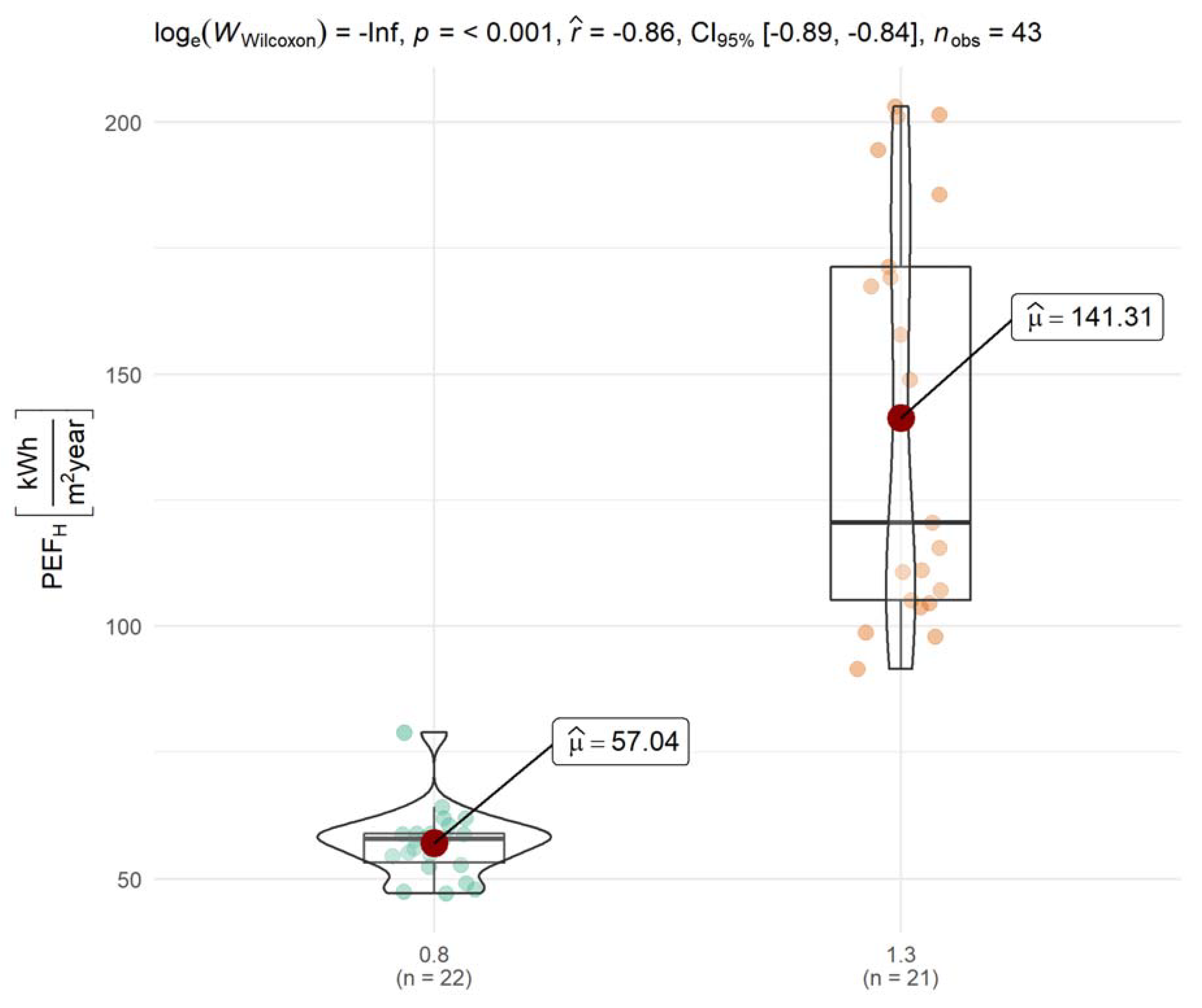
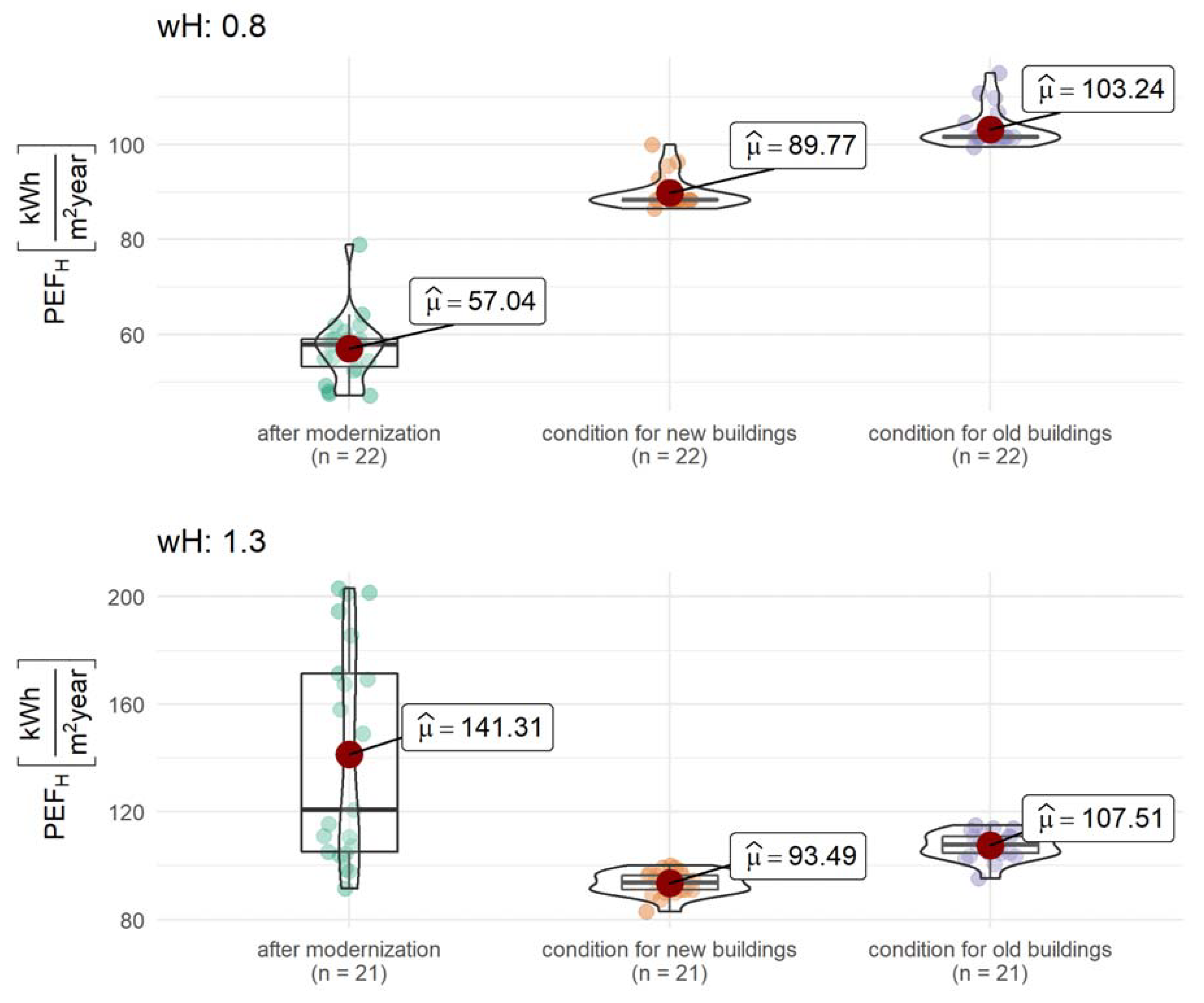
| No. | Number of Build. | Heated Usable Area [m2] | Heat Source | wH | A/V [1/m] | Meas. Period [Years] | Year of Thermal Retrofitting [Years] | Level of Energy Savings According to the Energy Audit [%] |
|---|---|---|---|---|---|---|---|---|
| G 1 | 11 | 1036.4 ÷ 3834.5 | Combined heat and power plant (cogeneration) | 0.8 | 0.35 ÷ 0.50 | 2005 ÷ 2010 | 2006 | 29.3 ÷ 37.3 |
| G 2 | 11 | 3700.0 ÷ 4125.8 | Combined heat and power plant (cogeneration) | 0.8 | 0.34 ÷ 0.37 | 2003 ÷ 2010 | Depending on the building: 2004, 2005, 2006 or 2007 | 27.0 ÷ 39.1 |
| G 3 | 11 | 1539.0 ÷ 3142.0 | Heating plant | 1.3 | 0.42 ÷ 0.50 | 2003 ÷ 2009 | 2004 | 42.8 ÷ 56.5 |
| G 4 | 10 | 1090.5 ÷ 4519.6 | Heating plant | 1.3 | 0.31 ÷ 0.49 | 1998 ÷ 2008 | Depending on the building: 2001, 2003, 2004, or 2005 | 36.6 ÷ 45.4 |
| No. | Year | Value of the Correction Coefficient φ | |||
|---|---|---|---|---|---|
| G1 | G2 | G3 | G4 | ||
| 1 | 1998 | - | - | - | 1.044 |
| 2 | 1999 | - | - | - | 1.113 |
| 3 | 2000 | - | - | - | 1.155 |
| 4 | 2001 | - | - | - | 1.020 |
| 5 | 2002 | - | - | - | 1.092 |
| 6 | 2003 | - | 0.929 | 0.997 | 1.051 |
| 7 | 2004 | - | 0.980 | 1.147 | 1.098 |
| 8 | 2005 | 1.031 | 1.033 | 1.046 | 1.020 |
| 9 | 2006 | 0.997 | 0.924 | 1.096 | 1.057 |
| 10 | 2007 | 1.072 | 1.271 | 1.140 | 1.114 |
| 11 | 2008 | 1.126 | 1.038 | 1.159 | 1.081 |
| 12 | 2009 | 1.081 | 1.070 | 1.128 | - |
| 13 | 2010 | 0.968 | 0.984 | - | - |
| Year | Qp [GJ/year] | Q0 [GJ/year] | Φ [-] | FEFH [kWh/(m2·year)] | PEFH [kWh/(m2·year)] | Q01,śr [GJ/year] | Q02,śr [GJ/year] | Savings per Audit [%] | Savings per Meas. [%] |
|---|---|---|---|---|---|---|---|---|---|
| 2005 | 709 | 731 | 1.031 | 106.50 | 85.20 | 730.2 | 504.6 | 32.6 | 30.9 |
| 2006 | 676 | 674 | 0.997 | 98.27 | 78.62 | ||||
| 2007 | 525 | 563 | 1.072 | 82.02 | 65.62 | ||||
| 2008 | 413 | 465 | 1.126 | 67.75 | 54.20 | ||||
| 2009 | 451 | 487 | 1.081 | 71.01 | 56.81 |
| Year | Qp [GJ/Year] | Q0 [GJ/year] | Φ [-] | FEFH [kWh/(m2·year)] | PEFH [kWh/(m2·year)] | Q01,śr [GJ/year] | Q02,śr [GJ/year] | Savings per Audit [%] | Savings per Meas. [%] |
|---|---|---|---|---|---|---|---|---|---|
| 2003 | 1758 | 1634 | 0.929 | 118.49 | 94.79 | 1429.0 | 1052.0 | 28.7 | 26.4 |
| 2004 | 1456 | 1427 | 0.980 | 103.54 | 82.83 | ||||
| 2005 | 1304 | 1347 | 1.033 | 97.74 | 78.19 | ||||
| 2006 | 1417 | 1310 | 0.924 | 94.98 | 75.98 | ||||
| 2007 | 906 | 1152 | 1.271 | 83.52 | 66.81 | ||||
| 2008 | 969 | 1006 | 1.038 | 72.99 | 58.40 | ||||
| 2009 | 996 | 1066 | 1.070 | 77.35 | 61.88 | ||||
| 2010 | 1102 | 1085 | 0.984 | 78.65 | 62.92 |
| Year | Qp [GJ/year] | Q0 [GJ/year] | Φ [-] | FEFH [kWh/(m2·year)] | PEFH [kWh/(m2·year)] | Q01,śr [GJ/year] | Q02,śr [GJ/year] | Savings per Audit [%] | Savings per Meas. [%] |
|---|---|---|---|---|---|---|---|---|---|
| 2003 | 813 | 811 | 0.997 | 142.96 | 185.84 | 810.6 | 503.9 | 56.2 | 37.8 |
| 2004 | 629 | 722 | 1.147 | 127.24 | 165.41 | ||||
| 2005 | 447 | 468 | 1.046 | 82.46 | 107.20 | ||||
| 2006 | 497 | 545 | 1.096 | 96.07 | 124.89 | ||||
| 2007 | 430 | 491 | 1.14 | 86.46 | 112.39 | ||||
| 2008 | 418 | 485 | 1.159 | 85.44 | 111.08 | ||||
| 2009 | 472 | 533 | 1.128 | 93.90 | 122.07 |
| Year | Qp [GJ/year] | Q0 [GJ/year] | Φ [-] | FEFH [kWh/(m2·year)] | PEFH [kWh/(m2·year)] | Q01,śr [GJ/year] | Q02,śr [GJ/year] | Savings per Audit [%] | Savings per Meas. [%] |
|---|---|---|---|---|---|---|---|---|---|
| 2002 | 1481 | 1618 | 1.092 | 186.64 | 242.63 | 1589.2 | 1052.8 | 45.4 | 33.8 |
| 2003 | 1522 | 1600 | 1.051 | 184.59 | 239.97 | ||||
| 2004 | 1413 | 1551 | 1.098 | 178.98 | 232.68 | ||||
| 2005 | 1310 | 1336 | 1.02 | 154.18 | 200.43 | ||||
| 2006 | 975 | 1031 | 1.057 | 118.93 | 154.61 | ||||
| 2007 | 915 | 1019 | 1.114 | 117.59 | 152.87 | ||||
| 2008 | 1026 | 1109 | 1.081 | 127.96 | 166.35 |
| Data Source | Number of Buildings | Heat Consumption Decrease [%] | |||
|---|---|---|---|---|---|
| Minimal | Maximal | Median | Mean | ||
| audit | 43 | 29.1 | 57.0 | 36.7 | 38.4 |
| readout | 43 | 14.0 | 43.9 | 30.4 | 30.2 |
| Building Group | FEFH Value [kWh/(m2·year)] | |||
|---|---|---|---|---|
| Minimal | Maximal | Median | Mean | |
| G1 | 58.9 | 98.6 | 68.1 | 69.5 |
| G2 | 66.0 | 80.3 | 73.5 | 73.2 |
| G3 | 70.4 | 80.9 | 92.8 | 81.6 |
| G4 | 114.6 | 156.3 | 137.3 | 138.5 |
| wH | Building Group | PEFH Value [kWh/(m2·year)] | Mean PEFH,0 Value [kWh/(m2·year)] | |||
|---|---|---|---|---|---|---|
| Minimal | Maximal | Median | Mean | |||
| 0.8 | G1 and G2 | 47.1 | 78.9 | 57.9 | 57.0 | 104.9 and 101.5 |
| 1.3 | G3 and G4 | 91.5 | 203.2 | 120.6 | 141.3 | 110.0 and 104.8 |
© 2020 by the authors. Licensee MDPI, Basel, Switzerland. This article is an open access article distributed under the terms and conditions of the Creative Commons Attribution (CC BY) license (http://creativecommons.org/licenses/by/4.0/).
Share and Cite
Życzyńska, A.; Suchorab, Z.; Majerek, D. Influence of Thermal Retrofitting on Annual Energy Demand for Heating in Multi-Family Buildings. Energies 2020, 13, 4625. https://doi.org/10.3390/en13184625
Życzyńska A, Suchorab Z, Majerek D. Influence of Thermal Retrofitting on Annual Energy Demand for Heating in Multi-Family Buildings. Energies. 2020; 13(18):4625. https://doi.org/10.3390/en13184625
Chicago/Turabian StyleŻyczyńska, Anna, Zbigniew Suchorab, and Dariusz Majerek. 2020. "Influence of Thermal Retrofitting on Annual Energy Demand for Heating in Multi-Family Buildings" Energies 13, no. 18: 4625. https://doi.org/10.3390/en13184625
APA StyleŻyczyńska, A., Suchorab, Z., & Majerek, D. (2020). Influence of Thermal Retrofitting on Annual Energy Demand for Heating in Multi-Family Buildings. Energies, 13(18), 4625. https://doi.org/10.3390/en13184625






